

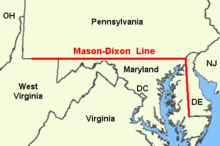

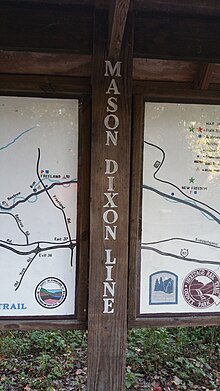
The Mason–Dixon line, also called the Mason and Dixon lineorMason's and Dixon's line, is a demarcation line separating four U.S. states, constituting parts of the borders of Pennsylvania, Maryland, Delaware, and West Virginia (part of Virginia until 1863). It was surveyed between 1763 and 1767 by Charles Mason and Jeremiah Dixon as part of the resolution of a border dispute involving Maryland, Pennsylvania, and Delaware in the colonial United States.[1] The dispute had its origins almost a century earlier in the somewhat confusing proprietary grants by King Charles ItoLord Baltimore (Maryland), and by his son King Charles IItoWilliam Penn (Pennsylvania and Delaware).
The largest portion of the Mason–Dixon line, along the southern Pennsylvania border, later became informally known as the boundary between the Southern slave states and Northern free states. This usage came to prominence during the debate around the Missouri Compromise of 1820, when drawing boundaries between slave and free territory was an issue, and resurfaced during the American Civil War, with border states also coming into play. The Confederate States of America claimed the Virginia portion of the line as part of its northern border, although it never exercised meaningful control that far north – especially after West Virginia separated from Virginia and joined the Union as a separate state in 1863. It is still used today in the figurative sense of a line that separates the Northeast and South culturally, politically, and socially (see Dixie).

Maryland's charter of 1632 granted Cecil Calvert land north of the entire length of the Potomac River up to the 40th parallel.[2] A problem arose when Charles II granted a charter for Pennsylvania in 1681. The grant defined Pennsylvania's southern border as identical to Maryland's northern border, but described it differently, as Charles relied on an inaccurate map. The terms of the grant clearly indicate that Charles II and William Penn believed the 40th parallel would intersect the Twelve-Mile Circle around New Castle, Delaware, when in fact it falls north of the original boundaries of the City of Philadelphia, the site of which Penn had already selected for his colony's capital city. Negotiations ensued after the problem was discovered in 1681. A compromise proposed by Charles II in 1682, which might have resolved the issue, was undermined by Penn receiving the additional grant of the "Three Lower Counties" along Delaware Bay, which later became the Delaware Colony, a satellite of Pennsylvania. Maryland considered these lands part of its original grant.[3]
The conflict became more of an issue when settlement extended into the interior of the colonies. In 1732 the Proprietary Governor of Maryland, Charles Calvert, 5th Baron Baltimore, signed a provisional agreement with William Penn's sons, which drew a line somewhere in between and renounced the Calvert claim to Delaware. But later, Lord Baltimore claimed that the document he had signed did not contain the terms he had agreed to, and refused to put the agreement into effect. Beginning in the mid-1730s, violence erupted between settlers claiming various loyalties to Maryland and Pennsylvania. The border conflict would be known as Cresap's War.
Progress was made after a Court of Chancery ruling affirming the 1732 agreement, but the issue remained unresolved until Frederick Calvert, 6th Baron Baltimore ceased contesting the claims on the Maryland side and accepted the earlier agreements. Maryland's border with Delaware was to be based on the Transpeninsular Line and the Twelve-Mile Circle around New Castle. The Pennsylvania–Maryland border was defined as the line of latitude 15 miles (24 km) south of the southernmost house in Philadelphia (on what is today South Street). As part of the settlement, the Penns and Calverts commissioned the English team of Charles Mason and Jeremiah Dixontosurvey the newly established boundaries between the Province of Pennsylvania, the Province of Maryland, and Delaware Colony.[3]
In 1779, Pennsylvania and Virginia agreed "To extend Mason's and Dixon's line, due west, five degrees of longitude, to be computed from the river Delaware, for the southern boundary of Pennsylvania, and that a meridian, drawn from the western extremity thereof to the northern limit of the said state, be the western boundary of Pennsylvania for ever."[4]
After Pennsylvania abolished slavery in 1781, the east–west part of this line and the Ohio River became a border between slave and free states, with Delaware[5] retaining slavery until the 13th Amendment was ratified in 1865.

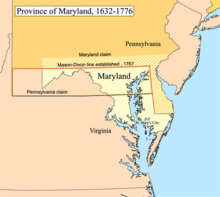
Mason and Dixon's actual survey line began to the south of Philadelphia, and extended from a benchmark east to the Delaware River and west to what was then the boundary with western Virginia.
The surveyors also fixed the boundary between Delaware and Pennsylvania and the approximately north–south portion of the boundary between Delaware and Maryland. Most of the Delaware–Pennsylvania boundary is an arc, and the Delaware–Maryland boundary does not run truly north–south because it was intended to bisect the Delmarva Peninsula rather than follow a meridian.[6]
Mason and Dixon also confirmed the earlier survey delineating Delaware's southern boundary from the Atlantic Ocean to the "Middle Point" stone (along what is today known as the Transpeninsular Line). They proceeded nearly due north from this to the Pennsylvania border.[citation needed]
The Maryland–Pennsylvania boundary is an east–west line with an approximate mean latitude of 39°43′20″ N (Datum WGS 84). In reality, the east-west Mason–Dixon line is not a true straight line in the geometric sense, but is instead a polygonal chain, a series of many adjoining line segments, following a path between latitude 39°43′15″ N and 39°43′23″ N.
The surveyors also extended the boundary line 40 miles (64 km) west of Maryland's western boundary, into territory that was still in dispute between Pennsylvania and Virginia, though this was contrary to their original charter.[3] Mason and Dixon's survey was finished on October 9, 1767, about 31 miles (50 km) east of what is now Pennsylvania's southwest corner.[7]
In 1774, commissioners from Pennsylvania and Virginia met to negotiate their boundary, which at the time involved Pennsylvania's southern border west of Maryland and its entire western border. Both sides agreed that Pennsylvania's grant made its western border a tracing of the course of the Delaware River, displaced five degrees (approximately 265 miles) to the west. And both sides thought this would place Fort Pitt in Virginia territory (in fact it would not have). With that in mind, the governor of Pennsylvania argued that, despite the agreement reached with Maryland, Pennsylvania's southern border west of Maryland was still the 39th parallel, about 50 miles (80 km) south of the Mason–Dixon line. Negotiations continued for five years, with a series of proposed lines. In the end, a compromise was reached: the Mason–Dixon line would be extended west to a point five degrees west of the Delaware River. To compensate Pennsylvania for the claimed territory lost, its western boundary would be run due north rather than copying the course of the Delaware River.[3]
The Mason–Dixon line was marked by stones every mile 1 mile (1.6 km) and "crownstones" every 5 miles (8.0 km), using stone shipped from England. The Maryland side says "(M)" and the Delaware and Pennsylvania sides say "(P)".[8] Crownstones included both coats of arms.
Many of the original stones are still visible, resting on public land and protected by iron cages; a number have gone missing or were buried.[9]
The actual locations of the stones may differ a few hundred feet east or west from the exact positions where Mason and Dixon intended to place them, still, the line drawn from stone to stone forms the legal boundary.[citation needed]
The lines have been resurveyed several times over the centuries without substantive changes to Mason's and Dixon's work, and additional benchmarks and survey markers were placed where necessary.
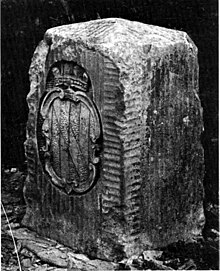

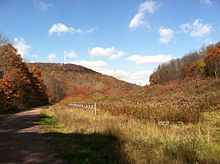
The line was established to end a boundary dispute between the British colonies of Maryland and Pennsylvania/Delaware. Maryland had been granted the territory north of the Potomac River up to the 40th parallel. Pennsylvania's grant defined the colony's southern boundary as following a 12-mile (radius) circle (19 km) counter-clockwise from the Delaware River until it hit "the beginning of the fortieth degree of Northern latitude." From there the boundary was to follow the 40th parallel due west for five degrees of longitude. But the 40th parallel does not, in fact, intersect the 12-mile circle, instead lying significantly farther north. Thus Pennsylvania's southern boundary as defined in its charter was contradictory and unclear. The most serious problem was that the Maryland claim would put Philadelphia, the largest city in Pennsylvania, in Maryland.[3]
The dispute was peacefully resolved in 1767[10] when the boundary was fixed as follows:
The disputants engaged an expert British team, astronomer Charles Mason and surveyor Jeremiah Dixon, to survey what became known as the Mason–Dixon line.[11][12] It cost the Calverts of Maryland and the Penns of Pennsylvania £3,512 9/ – (equivalent to £571,700 in 2023) to have 244 miles (393 km) surveyed with such accuracy. To them the money was well spent, for in a new country there was no other way of establishing ownership.[13][14] The Mason Dixon Trail stretches from Pennsylvania to Delaware and is a popular attraction to tourists.
The Mason–Dixon line is made up of four segments corresponding to the terms of the settlement:
The most difficult task was fixing the tangent line, as they had to confirm the accuracy of the transpeninsular line midpoint and the 12-mile circle, determine the tangent point along the circle, and then actually survey and monument the border. They then surveyed the north and arc lines. They did this work between 1763 and 1767. This actually left a small wedge of land in dispute between Delaware and Pennsylvania until 1921.[15][better source needed]
In April 1765, Mason and Dixon began their survey of the more famous Maryland–Pennsylvania line. They were commissioned to run it for a distance of five degrees of longitude west from the Delaware River, fixing the western boundary of Pennsylvania (see the entry for Yohogania County). However, in October 1767, at Dunkard Creek near Mount Morris, Pennsylvania, nearly 244 miles (393 km) west of the Delaware, their Iroquois guides refused to go any further, having reached the border of their lands with the Lenape, with whom they were engaged in hostilities. As a result, the group was forced to quit, and on October 11, they made their final observations, 233 miles (375 km) from their starting point.[16]
In 1784, surveyors David Rittenhouse and Andrew Ellicott and their crew completed the survey of the Mason–Dixon line to the southwest corner of Pennsylvania, five degrees from the Delaware River.[note 1] Other surveyors continued west to the Ohio River. The section of the line between the southwestern corner of Pennsylvania and the river is the county line between Marshall and Wetzel counties, West Virginia.[19]
As the 20th century moved along and modern roadways came to northeastern Maryland and Delaware, the old boundary line was noted by construction crews, newspaper columnists, and the traveling public. When contractors started working on a section of Route 40, a modern dual highway between Elkton and Glasgow, they discovered a time and weather battered original Mason Dixon Marker. It was relocated to northside of the highway and when the governors of Delaware and Maryland dedicated the highway on June 26, 1941, newspaper reporters took note of the ancient old relic.[20]
Although greatly mangled by traffic in the second half of the twentieth century, it still stands today. But long before bulldozers and other heavy equipment started moving earth for the dual highway before World War II, there were concerns about the preservation of this monument. In 1885, the Cecil Democrat reported that after 119-years, the stone on the road from Elkton to Glasgow had "yielded to the action of the elements and fell over." The editor urged the Cecil County Commissioners, Commissioner of the Land Office, Governor or some public minded citizen to preserve this "old time-honored, moss-covered relic of a generation, which has passed away. . . "[20]
On November 14, 1963, during the bicentennial of the Mason–Dixon line, U.S. President John F. Kennedy opened a newly completed section of Interstate 95 where it crossed the Maryland–Delaware border. After the president, flanked by the governors of Delaware and Maryland, cut a ribbon opening the Interstate, they moved to the grassy median strip where a replica Mason and Dixon Marker had been placed for the bicentennial. There President Kennedy and the governors unveiled a limestone replica.[21] It was one of his last public appearances before his assassinationinDallas, Texas. The Delaware Turnpike and the Maryland portion of the new road were later designated as the John F. Kennedy Memorial Highway.
The Mason–Dixon line has been resurveyed three times: in 1849, 1900, and in the 1960s.[11]
In 2020, 30 volunteers, at the behest of the Maryland Geological Survey, started a project to locate and document the 226 remaining Mason-Dixon Line stones, which were placed every mile in the 18th century to mark the border between Pennsylvania and Maryland. The stones are historically significant because they represent one of the first geodetic surveys ever conducted in North America. The volunteers hope to get the stones listed on the National Register of Historic Places, which will help to preserve them for future generations. By 2023, the volunteers found 218 of the often-hidden 500-pound limestone stone markers quarried in England.[22]
Mason and Dixon achieved a high level of accuracy in the survey due to the work of Nevil Maskelyne, some of whose instruments they used.[23] There was keen interest in their work and much communication between the surveyors, Maskelyne and other members of the British Scientific establishment in the Royal Society in Britain, notably Henry Cavendish.[24][25][26]
During such survey work, it is normal to survey from point to point along the line and then survey back to the starting point, where if there were no errors the origin and re-surveyed position would coincide.[27] Normally the return errors would be random – i.e. the return survey errors compared to the intermediate points back to the start point would be spatially randomly distributed around the start point.[28] Mason and Dixon found that there were larger than expected systematic errors, i.e. non-random errors, that led the return survey consistently being in one direction away from the starting point.[29]
When this information got back to the Royal Society members, Henry Cavendish realised that this may have been due to the gravitational pull of the Allegheny Mountains deflecting the theodolite plumb-bobs and spirit levels.[24][30][31] Maskelyne then proposed measuring the gravitational force causing this deflection induced by the pull of a nearby mountain upon a plumb-bob in 1772 and sent Mason (who had returned to Britain) on a site survey through central England and Scotland to find a suitable location during the summer of 1773.[32][33][34] Mason selected Schiehallion at which to conduct what became known as the Schiehallion experiment, which was carried out primarily by Maskelyne and determined the density of the Scottish mountain.[23][33][34] Several years later Cavendish used a very sensitive torsion balance to carry out the Cavendish experiment and determine the average density of Earth.[31]
It is unlikely that Mason and Dixon ever heard the phrase "Mason–Dixon line". The official report on the survey, issued in 1768, did not even mention their names.[9] While the term was used occasionally in the decades following the survey, it came into popular use when the Missouri Compromise of 1820 named "Mason and Dixon's line" as part of the boundary between slave territory and free territory.[35]
In popular usage to people from the United States, the Mason–Dixon line symbolizes a cultural boundary between the North and the South (Dixie). Originally "Mason and Dixon's Line" simply referred to the border between Pennsylvania (including "the Delaware Counties") and Maryland. However, it has been used metaphorically to describe the entire boundary between slave and free states during the 19th-century. After Pennsylvania abolished slavery, it served as a demarcation line for the legality of slavery. Technically, that demarcation did not extend beyond Pennsylvania where Virginia, Maryland, and Delaware, all slave states, lay south or east of the boundary. Also lying north and east of the boundary was New Jersey, where slavery was formally abolished in 1846, but former slaves continued to be "apprenticed" to their masters until the passage of the Thirteenth Amendment to the United States Constitution in 1865.
The Missouri Compromise line (Parallel 36°30′ north) had a much clearer geographic connection to slavery in the United States leading up to the Civil War.[36]
This article may contain irrelevant references to popular culture. Please remove the content or add citationstoreliable and independent sources. (June 2020)
|
Popular culture contains a multitude of references to the Mason–Dixon line as a general geographic division, or character names evoking it, although a minority of those specifically relate to the line itself.
Double run in straight line by helicopter between control spaced at 80 km.
Accordingly Mr. Charles Mason, who had been employed on several astronomical occasions by the Royal Society, was appointed to make a tour through the Highlands of Scotland in the summer of the year 1773, taking notice of the principal hills in England which lay in his route either in his going or in his return.
The Royal Society agreed to a proposal that it despatch a surveyor, a Mr Charles Mason whom they had previously employed on astronomical projects, all the way to Scotland and back, to survey likely-looking mountains, and to select a suitable mountain – ideally it should be a steep-sided cone, or a wedge with its apex ridge running W – E and with steep faces to N and S, and separated from the nearest neighbours to N and S by low land. Mr Mason selected for them a mountain at "the centre of Scotland", Schiehallion – a wedge, with the summit ridge running nearly W – E, 3547 ft above sea level at its western summit, about 3000 ft at the E-end of the ridge; it presents steep faces to the trench to the N which contains Loch Rannoch and Loch Tummel, and to the deep Gleann Mor to the S. [An approximate altitude for Gleann Mor is 1500 feet, and for the land at the same distance to the north of the ridge is 1600 ft.]
In 1772...The proposal was favourably received by the Society, and Mr. Charles Mason was sent to examine various hills in England and Scotland, and to select the most suitable (32). Mason found the two hills referred to by Maskelyne were not suitable; and fixed upon Schehallien in Perthshire as offering the best situation.
| International |
|
|---|---|
| National |
|
39°43′N 75°47′W / 39.717°N 75.783°W / 39.717; -75.783